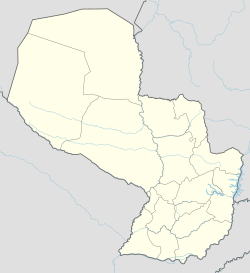Areguá
Areguá Aregua | |
|---|---|
Clockwise from top: an artisans' market, the welcome sign in front of the main church and a view from Areguá Beach. | |
| Etymology: People from above | |
| Nickname(s): City of Strawberries | |
| Government | |
• Mayor | Humberto Denis Torres Fleytas (ANR) |
| Area | |
• Total | 105 km2 (41 sq mi) |
| Elevation | 70 m (230 ft) |
| Population | |
• 2023 estimate | 83,028[1] |
• Density | 642.73/km2 (1,664.7/sq mi) |
| Time zone | UTC-3 |
| Calling code | 291 |
| Website | https://www.municipios.gov.py/aregua/ |
Areguá is a creative city and the capital of Central Department in Paraguay. It is known for its production of strawberry products, pottery, colonial architecture and historic cobblestone streets.
The district lies between the Ypacaraí Lake and the basin it forms with the Salado River to the East and hills to the West.
Etymology
[edit]

Areguá is thought to come from Classical Guarani ariguâ·r ("[person/people] from above, from up there"), refererring to the area's high altitude and its first inhabitants from the Mbya Guarani tribes.[2]
History
[edit]Areguá was founded by Domingo Martínez de Irala in 1538.[3] Early settlers, numbering about 200, lived close to the church. They were Mercedarians who arrived with the Spanish to raise cattle. African slaves were put to work on these farms.[4]
By the end of the 19th century, Areguá had become a tourist destination to which many writers, artists and intellectuals from nearby areas retreated in the summer.
It was promoted to district status on November 12, 1862 by Francisco Solano López.
In 2019, it was designed as a city of crafts and folk arts by the UNESCO as part of its Creative Cities Network.[5][6]
Geography
[edit]Areguá is divided in twenty-four companies:
| 1 | San Miguel | 13 | Costa Fleitas |
| 2 | Santo Domingo | 14 | Jukyty |
| 3 | San Roque | 15 | Valle Pucú |
| 4 | Las Mercedes | 16 | Jukyry |
| 5 | Boquerón | 17 | Isla Valle |
| 6 | San Cayetano | 18 | San Miguel |
| 7 | Santa Catalina | 19 | Caacupemí |
| 8 | Estanzuela | 20 | Fracción Yvoty |
| 9 | Kokue Guasu | 21 | Fracción Alicia |
| 10 | Pindolo | 22 | Villa Salvador |
| 11 | San Antonio | 23 | Villa Rosita |
| 12 | María Auxiliadora | 24 | Tajy Poty |
Climate
[edit]Areguá's climate is temperate. Maximum summer temperatures reach 40°C. Average winter temperatures are 0°C. The average annual rainfall is 1377mm distributed throughout the year.
Demography
[edit]Areguá's population is about 67,847. Of these residents, 33,870 are female and 33,977 are male.[7]
Culture
[edit]Areguá's economy is based on strawberry farming. The town is also known for its pottery, which is an emergent industry in the region.
Every year, the Strawberry Expo takes place in Areguá. It consists of a month-long strawberry festival where farmers and producers sell strawberries and strawberry products (from juice, cakes and liquors to ice cream, empanadas and pastafrolas).[8]
The district's patronal festival is February 2 (Virgin of Candelaria). Celebrations last around ten days, these include: a novena, a folk festival, serenatas and a procession that takes the image of the Virgin of Candelaria to schools, businesses and chapels, among other places.[9]
Places of interest
[edit]Areguá has a historic area centred on Avenida del Lago (Lake Avenue) which runs from a hilltop church to the Ypacaraí Lake. In 1997, the Paraguayan parliament declared it a National Heritage Area.
Isla Valle, the local ecological organization, regulates fishing in the lake.[10]
Another attraction is the Centro Artesanal de la Cuenca. At the Center, craftsmen from the region display locally made pottery and crafts. Aregua also has art galleries, including Guggiari Arte, Luis Cogliolo Galería de Arte, Paseo La Candelaria, Areguá pesebres, El Cántaro, and Museo las Margaritas.
The Koi and Chorori hills are a geologic attraction. Koi Hill is known for its formations of hexagonal sandstone.[11] The formations are a protected heritage site and the hill was declared a Natural Monument in 1993.
Notable people
[edit]The Paraguayan writer Gabriel Casaccia was born in Areguá.
References
[edit]- ^ Proyección de la población por sexo y edad, según distrito, 2000-2025 (PDF) (in Spanish) (2015 Revision ed.). Paraguay: National Institute of Statistics. p. 453.
- ^ lanaciongn (2020-01-19). "Diario HOY | Areguá, herencia de ancestros, donde del barro se hace arte". Diario HOY (in Spanish). Retrieved 2023-06-03.
- ^ Macgregor J. The Progress of America from the Discovery by Columbus to the Year 1846 Whittaker & Company, 1847 p. 1028
- ^ Walker S. S. African Roots/American Cultures: Africa in the Creation of the Americas Rowman & Littlefield, 2001 p. 320 ISBN 0742501655
- ^ "Portal Oficial del Ministerio de Relaciones Exteriores de la República del Paraguay :: Areguá fue designada por la UNESCO como Ciudad Creativa". www.mre.gov.py. Retrieved 2023-05-29.
- ^ "Areguá | Creative Cities Network". en.unesco.org. Retrieved 2023-05-29.
- ^ Paraguay population Country Economy website. 2008.
- ^ "Expo Frutilla". Visita Paraguay. Retrieved 2023-05-24.
- ^ "Luego de larga ausencia, la Virgen reúne a devotos - Fiesta Patronal San Blas y Virgen de la Candelaria 2022 - ABC Color". www.abc.com.py (in Spanish). Retrieved 2023-06-03.
- ^ "Islavalle". Archived from the original on 2017-09-11. Retrieved 2017-07-20.
- ^ Eckel E. B. and Milton C. Geological and Mineral Resources of Paraguay U.S. Government Printing Office, 1959 p. 34







